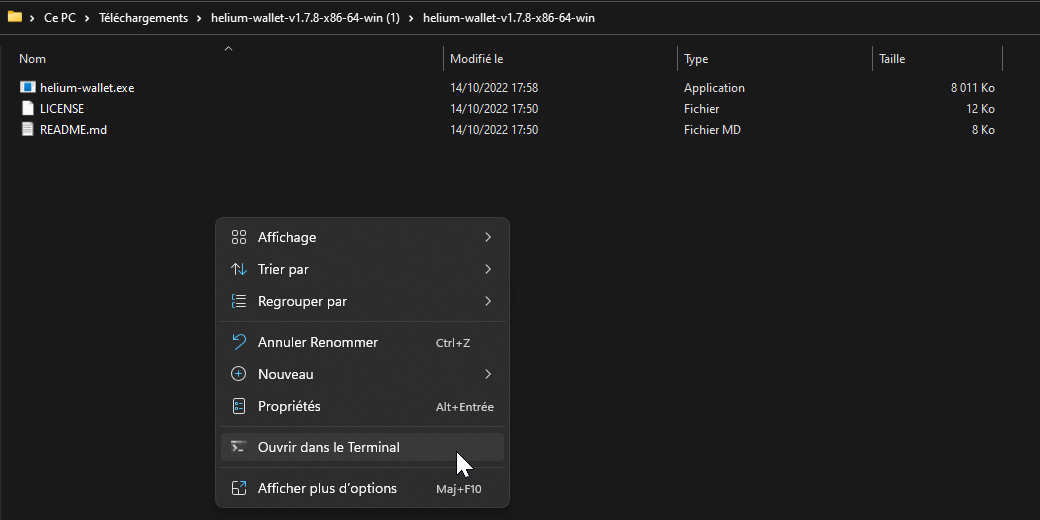Table of Contents
Helium CLI
The Helium Command Line Interface (CLI) wallet is the most flexible of the wallet options but it also requires more technical knowledge. As such, it is suitable for all types of transactions, but requires more caution on behalf of its users. Helium CLI
Assert location
First Assert location
- Download Helium-wallet application
- Take care to select the good version depending of your computer OS (following example is for Windows 11)
- Create or import your existing wallet, like explain here
helium-wallet hotspots assert --commit --onboarding --elevation=<elevation> --gain=<gain> --lat=<lattitude> --lon=<longitude> --gateway <gateway>
Description of the command:
./helium-wallet hotspots assert -h
helium-wallet-hotspots-assert 1.7.4
Assert a hotspot location on the blockchain. The original transaction is created by the hotspot miner and supplied here for owner signing.
Use an onboarding key to get the transaction signed by the DeWi staking server
USAGE:
helium-wallet hotspots assert [FLAGS] [OPTIONS] --gateway <gateway>
FLAGS:
--commit Commit the transaction to the blockchain
-h, --help Prints help information
--onboarding Use the DeWi "staking" server to pay for the assert location.
Note that no, or only a limited number of asserts may available for use by the staking server
-V, --version Prints version information
OPTIONS:
--elevation <elevation> The elevation for the asserted hotspot in meters above ground level.
Defaults to the last assserted value. For negative values use '=', for example: "--elevation=-xx"
--gain <gain> The antenna gain for the asserted hotspotin dBi, with one digit of accuracy.
Defaults to the last asserted value
--gateway <gateway> Address of hotspot to assert (Miner public key)
--lat <lat> Lattitude of hotspot location to assert. Defaults to the last asserted value.
For negative values use '=', for example: "--lat=-xx.xxxxxxx"
--lon <lon> Longitude of hotspot location to assert. Defaults to the last asserted value.
For negative values use '=', for example: "--lon=-xx.xxxxxxx"
--mode <mode> The staking mode for the assert location (full, light, dataonly).
Defaults to the stakng mode the hotspot was added with
Reassert location
- Download Helium-wallet application
- Create or import your existing wallet, like explain here
- Use the following command to do an assert location:
helium-wallet hotspots assert --commit --elevation=<elevation> --gain=<gain> --lat=<lattitude> --lon=<longitude> --gateway <gateway>
Description of the command:
./helium-wallet hotspots assert -h
helium-wallet-hotspots-assert 1.7.4
Assert a hotspot location on the blockchain. The original transaction is created by the hotspot miner and supplied here for owner signing.
Use an onboarding key to get the transaction signed by the DeWi staking server
USAGE:
helium-wallet hotspots assert [FLAGS] [OPTIONS] --gateway <gateway>
FLAGS:
--commit Commit the transaction to the blockchain
-h, --help Prints help information
--onboarding Use the DeWi "staking" server to pay for the assert location.
Note that no, or only a limited number of asserts may available for use by the staking server
-V, --version Prints version information
OPTIONS:
--elevation <elevation> The elevation for the asserted hotspot in meters above ground level.
Defaults to the last assserted value. For negative values use '=', for example: "--elevation=-xx"
--gain <gain> The antenna gain for the asserted hotspotin dBi, with one digit of accuracy.
Defaults to the last asserted value
--gateway <gateway> Address of hotspot to assert (Miner public key)
--lat <lat> Lattitude of hotspot location to assert. Defaults to the last asserted value.
For negative values use '=', for example: "--lat=-xx.xxxxxxx"
--lon <lon> Longitude of hotspot location to assert. Defaults to the last asserted value.
For negative values use '=', for example: "--lon=-xx.xxxxxxx"
--mode <mode> The staking mode for the assert location (full, light, dataonly).
Defaults to the stakng mode the hotspot was added with


